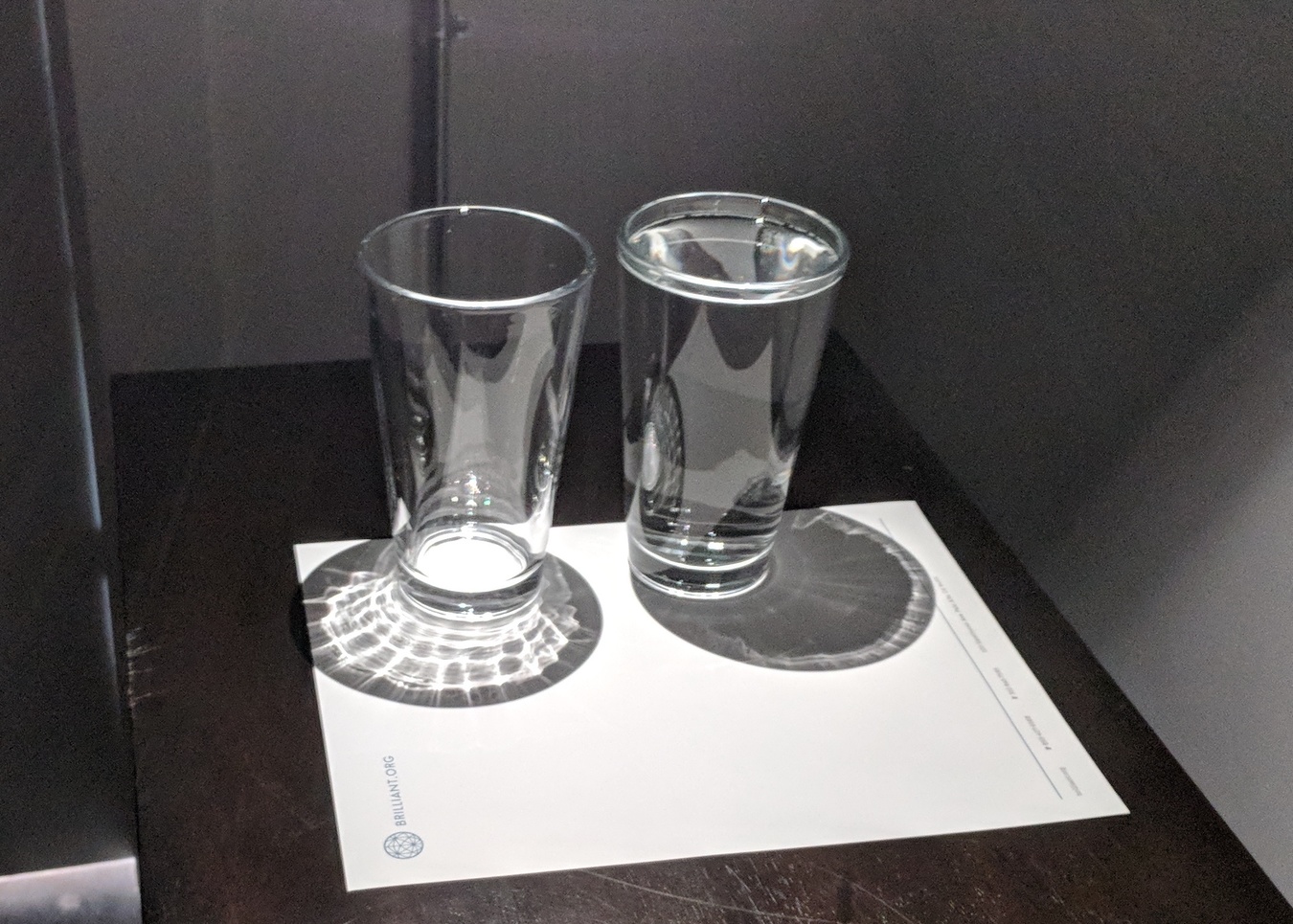Water Shadows
Why does a full glass of water cast a darker shadow than an empty glass?

This section requires Javascript.
You are seeing this because something didn't load right. We suggest you, (a) try
refreshing the page, (b) enabling javascript if it is disabled on your browser and,
finally, (c)
loading the
non-javascript version of this page
. We're sorry about the hassle.
2 solutions
I don’t like these questions with more than one correct answer. The transmisivity of water is less than that if air, so more light is absorbed in water than air and thus a transparent object full of water will indeed cast a darker shadow, regardless of refraction.
Log in to reply
There isn't much difference in transmittance between water and air. If you look at the glass filled with water, you can see through it, it is not opaque. So difference in transmittance is not the correct answer.
If the light is refracted towards the bottom, why doesn’t the bottom light up then? The empty glass clearly shows a lit bottom.
Secondly, if light is only reflected, then the amount of casted shadow should be the same, depending on the definition of “a darker shadow”. What is a darker shadow? Is a shadow darker when the added up absence of light refracted towards the camera is bigger? Or when the area with less light is bigger? Should you let the answer depend on the point of view? If no light is lossed at all (because it is supposedly only refracted) then there should be no difference in the amount of shadow (i.e. Absence of light refracted towards whatever point of view).
The water doesn't look very clear in the picture. Without additional information, the best choice would be to assume that it is and move on. I did an experiment and light was brighter beneath the filled glass but, it had a significant amount of light shinning on the wall, reflected by the surface of the water. I get it, water should refract towards the bottom. The difference refractive index between glass and air is greater than the difference between air and water (1.5 to 1.0003 versus 1.3 to 1.0003), the water to glass interface will reflect some energy as well. However, this problem seems to involve assumptions and acquired knowledge with little problem solving required.
I didn't know the answer so I guessed and checked. I would rate this problem a 9 because it was quite confusing. How does the water bend the light?
If the water has impurities that seriously affect the light travelling through it, it would not appear as a clear liquid. Instead it probably would absorb the light. However, the mentioned effect occurs for distilled water as well. So the first and third answer are incorrect. The fourth answer, that an empty glass reflects more light, would imply that more light would be sent back towards the light source, instead of passing through the glass to the table. So it also cannot be correct, as it would have the opposite effect.
By elimination, the second answer must be correct. Indeed, light entering the glass from the top will be refracted by the water, which has a refractive index higher than air. As such the light in the water will be aimed more downward towards the bottom of the glass. Additionally, light managing to reach the sides of the glass will do so nearly perpendicularly to the glass surface. As such it is very likely to be reflected, and again will be headed towards the bottom of the glass.
So specifically for the case of lighting from the top, as in the photo, the shadow of a full glass will indeed be darker, and the surface below the glass will instead be brighter. Refraction (and also reflections) cause this effect. And the second answer is indeed mostly correct, though not entirely complete.
Very clear... Thanks a lot.
The empty glass of water has a lighter shadow than the glass with water in it mainly because the glass without water only casts a shadow of the glass and light can go through it easily due to the fact there is no water in the way the water has plenty of minerals inside of it there for the water would cast a darker shadow that the normal glass Now some may want to ask me after reading this "well how can a glass as clear as the water have lighter shadow that the glass with water in it?" I can answer this easily the water fills the glass which gives it a much darker shadow, lets say you have a glass cylinder the glass would cast a darker shadow than a normal glass due to the fact that it has no space therefore it casts a shadow.
I thought light doesn't bend (and thats why you cant see around a corner). I've always presumed that light changes direction as opposed to bending??
Log in to reply
Or its because the corner is blocking your line of sight.
Actually, light does "bend around corners" - it's called diffraction! Look up diffraction patterns, and also check out Double Slit and Single Slit experiments :)
Thank you for clarifying that this situation arises specifically because of the angle of the light source!
The water in the glass refracts the light towards the normal or towards the base of the glass (Because the light is entering from rarer medium to denser medium it will refract towards the normal) which means that the refracted light (more clearly the shadow of the water in the glass) will strike the surface around the bottom of the glass .